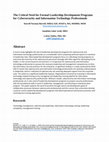Papers by Calvin Nobles

HOLISTICA – Journal of Business and Public Administration, 2018
Human factors remained unexplored and underappreciated in information security. The mounting cybe... more Human factors remained unexplored and underappreciated in information security. The mounting cyber-attacks, data breaches, and ransomware attacks are a result of human-enabled errors, in fact, 95% of all cyber incidents are human-enabled. Research indicates that existing information security plans do not account for human factors in risk management or auditing. Corporate executives, managers, and cybersecurity professionals rely extensively on technology to avert cybersecurity incidents. Managers fallaciously believe that technology is the key to improving security defenses even though research indicates that new technologies create unintended consequences; nonetheless, technological induced errors are human-enabled. Managers’ current perspective on the human factors problem information security is too narrow in scope and more than a training problem. The management of complex cybersecurity operations accompanied by mounting human factor challenges exceeds the expertise of most info...

International Journal of Hyperconnectivity and the Internet of Things
Two significant issues loom throughout the cybersecurity domain. The first is the shortage of cyb... more Two significant issues loom throughout the cybersecurity domain. The first is the shortage of cybersecurity professionals and the second quandary is the lack of minimum entry standards in cybersecurity. Some organizations' cybersecurity operations are suffering due to the cybersecurity talent gap accompanied by the increasing sophistication and number of cyber-attack attempts. The shortage of cyber talent is rampant in private entities as in public agencies, which highlights the resolve for entry standards into cybersecurity to enhance the professionalization. Researchers and practitioners provide countless recommendations for ameliorating the cybersecurity workforce by addressing the professionalization issue. Professional associations are the nexus of cybersecurity and possess the expertise, leadership, and sustenance to spearhead efforts to develop national-level strategies to resolve the talent gap and establish professionalization standards.

International Journal of Hyperconnectivity and the Internet of Things
The U.S. financial sector is the bedrock of the economic health and strategic advancement. As a c... more The U.S. financial sector is the bedrock of the economic health and strategic advancement. As a critical infrastructure, the financial sector continuously faces cyber-attacks and other nefarious activity. The financial sector is undergoing a technological explosion and forcing banks and financial institutions to implement cutting edge technologies. Even though technological breakthroughs are yielding competitive advantages; consequently, the same technologies are more prone to cyber-attacks stemming from technologically-induced vulnerabilities. The integrative and hyperconnected state of the financial industry and the domestic and global financial ecosystems are highly centralized and vulnerable to sophisticated cybersecurity threats, human factors, social engineering, credit card fraud, and online banking schemes. Any attempts to degrade, disrupt, or deny vital services and transactions in the financial industry could be conceived as an infringement and blockade of the U.S. global ...

Title: Security Solutions for Hyperconnectivity and the Internet of Things, 2017
Civil aviation faces increased cybersecurity threats due to hyperconnectivity and the lack of sta... more Civil aviation faces increased cybersecurity threats due to hyperconnectivity and the lack of standardized frameworks and cybersecurity defenses. Educating the civil aviation workforce is one method to enhance cyber defense against cyber-attacks. Educating the workforce will lead to initiatives and strategies to combat cyber-attacks. Private and public entities need to remain aggressive in developing cyber defense strategies to keep pace with the increasing vulnerabilities of hyperconnectivity. Areas that require immediate attention to safeguard against cybersecurity threats in civil aviation are: 1) Eliminating supply risks, 2) Upgrading legacy systems, 3) Mitigating technological aftereffects, 4) Increasing cybersecurity awareness, 5) Developing cybersecurity workforce, 6) Managing hyperconnectivity, and 7) Leveraging international entities. To safeguard civil aviation infrastructure from cybersecurity threats require assertive, coordinated, and effective strategies and capabilities to defend the network.

A recent study highlights the lack of leadership development programs for cybersecurity and infor... more A recent study highlights the lack of leadership development programs for cybersecurity and information technology professionals as a considerable void in preparing technical experts to transition to leadership roles. Most leadership development programs focus on cultivating training programs to overcome the enormity of the cybersecurity personnel shortage with little regard for developing future leaders. In the current business environment, it is imperative for cybersecurity and information technology professionals to possess the necessary leadership and management competencies to drive the information security practices for the enterprise. A significant finding in a study conducted by Oltsik (2017) reveals that cybersecurity and information technology professionals are woefully underprepared in leadership, which is indicative of cybersecurity not receiving adequate support from the corporate suite. This points to a significant leadership impasse. Organizations misconstrue investing in information technology related training as the managerial and leadership training pipeline for information technology and cybersecurity professionals. Without a doubt, cybersecurity and information technology professionals are in dire need of leadership development programs to prepare security professionals with the foundational skills to excel in leadership, management, and directing an enterprise-level program. This paper explores the world of practice through nature and development goals of collaborative processes between cybersecurity professionals and the manner that universities develop customer-centric leadership development programs that blend operational and business practices with contemporary training approaches.

The underrepresentation of women and minorities in computer science has been a concern to governm... more The underrepresentation of women and minorities in computer science has been a concern to government, industry, and academia for more than 10 years. Researchers are indicating that within the Science, Technology, Engineering, and Mathematics (STEM) domain, computer science is expected to experience the extensive growth through 2020 in the U.S.: yet, the pipeline struggles to produce enough college graduates to meet the demand. The shortage of computer scientists becomes more cumbersome when women and minorities remain significantly underrepresented, which means that women and people of color need more initiatives for inclusion in the equation. Organizations with Information Technology Departments have challenges with hiring cybersecurity professionals in this hypercompetitive environment due to a talent shortage. Considering the complexity of acquiring engineering and technical talent for organizations, highlights a deficiency in strategic initiatives aiming to hire more women and minority computer scientists and computer engineers. Diversity promotes differences in thinking and perspectives, enabling organizations to discover new vectors for problem solving, which have a dramatic impact on operational successes. Social scientists indicate that socially diverse groups and people with various specialties are more advantageous than a homogeneous group at solving complex, emergent problems. This is not only because people with different backgrounds provide different perspectives. Diversity can enhance the bread of knowledge and incite new practices by adding to an organization's intellectual capacity and innovative ideology. A diverse workforce is a core capability that provides organizations with a strategic advantage by approaching problems, projects, and strategies with holistic viewpoints such as minority computer scientists and engineers providing critical cultural and gender-based perspectives on engineering problems that are stymied due to shortsighted vantage points.
Academic Contributions by Calvin Nobles

International Journal of Applied Management Theory and Research, 2019
The growth and development of cybersecurity jobs and careers have created a need for new skilled ... more The growth and development of cybersecurity jobs and careers have created a need for new skilled faculty that can effectively teach the appropriate content to students at all levels. Often instructors are hired based on their academic credentials and professional experience without the use of assessment and faculty development methods to discover if these instructors can teach effectively or even improve the way they teach. Effective instructors have the ability constructively adjust teaching approaches when students are excelling or struggling based on skillful observation and constant assessment. If a student learns something with great ease, perhaps that approach would be of benefit to others. Part of what helps novices develop expertise here is their explicit attempt to understand how and why something works for students. The implementation and use of microteaching can provide a quality improvement approach to help cybersecurity instructors on all levels improve their ability to teach effectively.






Uploads
Papers by Calvin Nobles
Academic Contributions by Calvin Nobles